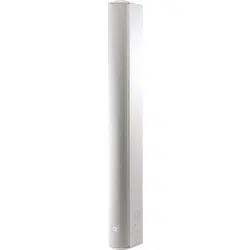Loading ...
Loading ...
Loading ...

CBT Quick Start Guide
20
Design Conclusions
Vertical Coverage Setting vs. Installation Height – In general, when the CBT speaker is set to the
Narrow vertical coverage setting, the speaker tends to cover best when installed fairly low and angled at a
fairly narrow down-tilt angle in relation to the seating plane.
Note that this mounting height may still be higher than is typically used with other competitive ‘column’
type loudspeakers which often exhibit a narrowing of the vertical beamwidth as the frequency range
increases. By comparison, the CBT Series products maintain a much more even vertical beamwidth,
allowing for more even coverage of the entire audience area.
When the speaker is set to the BROAD vertical coverage setting, it often results in best coverage with the
speaker installed higher and then angling at a steeper down-tilt angle.
Single vs. Multiple CBT Columns – These examples show sectional views of the venues as being
covered by a single CBT loudspeaker, but multiple speakers may be required.
• For Width -- Excellent coverage results can be achieved across the width of most rooms with CBT
speakers allowing expanded left to right placement given the CBT’s wider horizontal coverage
pattern, more so than is typically expected with conventional speaker systems. However, multiple
CBT’s may be needed to cover the width of a room, so a horizontal coverage assessment via a
plan-view should be done.
• For Depth -- It may be advisable to cover balconies or rear seating areas with a second CBT (or
other speaker). The second CBT may be mounted much higher up on the same front wall and set
at its Narrow vertical coverage setting to throw farther. Or, it may be positioned farther back in the
room – closer to the listeners – and delayed to synchronize with any arrival from the front/main
speaker (or with as much additional delay to keep localization to the front speaker, if that is desired
in the application). In this case, the delay speaker would usually be set to the Broad coverage
setting because it is closer to the listeners.
The designer needs to determine the acceptability of time-offset vs. SPL for any overlap areas.
An example of a venue where multiple speakers would be advisable would be a room where there
could be an issue with reflection from the front of a balcony. Using a second speaker with each
focusing sound on its own listening plane could reduce the amount of sound being sent to the front-
of-balcony surface and thereby reduce the amount of sound that is reflected from it back to the
stage (or to seats in the front, which could cause time-smear issues for those listeners).
Front-Fill – While the CBT columns do an admirable job of covering much of the seating area from a
single speaker, it may be worthwhile to add some front-fill speakers to cover front corners of the listening
space. In addition, it may also be useful in some cases to aim the speakers slightly higher or to change
to the Narrow coverage mode and add some mid-high front-fill speakers to cover the first few rows.
This can be a useful technique for further reducing sound reaching a stage area.
Loading ...
